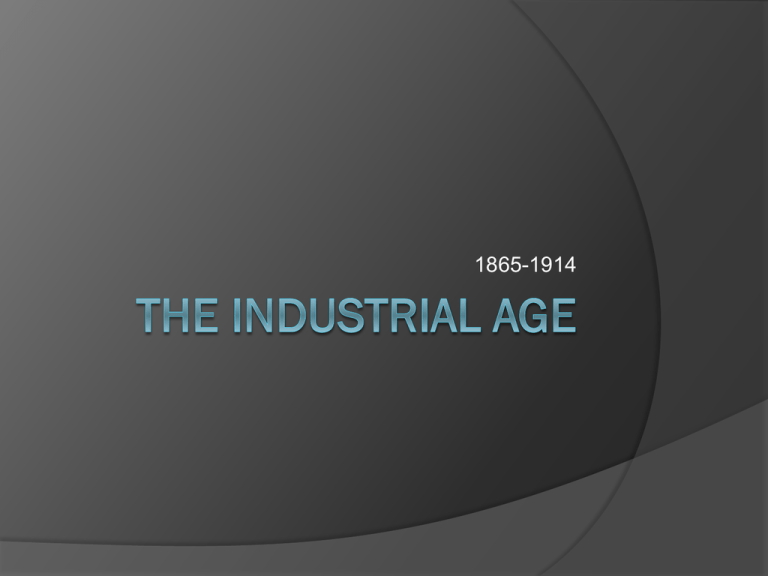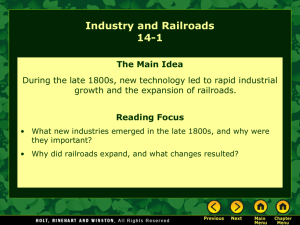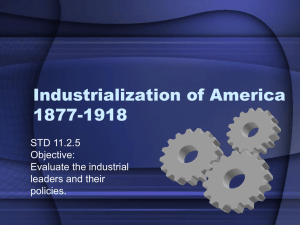The Industrial Age
advertisement

1865-1914 Railroads Lead the Way! Essential Question How did railroad expansion affect the United States economy? Railroad Expansion Railroad expansion is accompanied by consolidation Large companies buy smaller companies or drive them out of business Makes large companies more efficient Makes industrial processes more uniform Railroads Stimulate the Economy Railroads brought major changes to American industry and American life Connect east and west coast Railroads stimulate Steel Industry Lumber Industry Coal Industry Competing for Customers Large railroads offered rebates to their biggest customers Smaller railroads are forced out of business Raised freight rates for farmers and customers shipping small amounts of goods Railroad industry business leaders formed pools Combining resources to raise prices Laissez-faire: Government hands off the economy!!!! Answer the Essential Question How did railroad expansion affect the United States economy? ~ Railroad expansion allowed a few powerful individuals to build great fortunes ~ It benefited coal, iron and steel industries ~ Opened up the entire United States to economic growth Making Connections How did industrialists and their companies build their fortunes? ~ By consolidating small companies into large companies ~ Offering rebates to companies shipping large amounts of goods Making Connections Do you think owners of small farms supported the rebates given by railroad companies? ~ No, because the rebates were given only to large customers and freight rates increased for small farmers. Inventions Essential Questions How did the inventions of the late 1800s revolutionize society? Inventions By 1920, Americans in cities drove cars through streets lit with electric lights. They went to department stores where they bought everything from kitchen sinks to shoes. Americans also could do their shopping by mail – or pick up the telephone and order groceries from the local store. The automobile, the electric light and the telephone were invented after 1870. Inventions Within a generation, they became part of everyday life for millions of people. These new inventions helped people communicate more quickly over long distances. Improvements in communication helped unify the country and promoted economic growth. Inventions Telegraph (1844) – Samuel Morse Operators sent messages in morse code Offers instant communication Connects United States and Europe Inventions Telephone (1876) – Alexander Graham Bell Businesses are first to use phones Instant communication Eventually telephones become common in homes Inventions Electric Light Bulb (1879) – Thomas Edison “The Wizard of Menlo Park” Electric Power Plant Factories, trolleys, streetlights, and lamps are powered by electricity Inventions Engine Powered Aircraft (1903) – “The Wright Brothers” Oliver and Wilbur “Broke the bonds of Earth and see the world in a new way” Attracted attention of United States military in 1911 Inventions Wright Brothers Henry Ford’s Automobile 1903 – Henry Ford established his own auto making company in Detroit, Michigan and began designing cars 1908 – Model T is introduced Immensely popular Affordable and easy to keep in repair Assembly Line revolutionized industry Mass production decreased manufacturing costs so products could be sold more cheaply Model T Assembly Line Answer the Essential Question How did the inventions of the late 1800s revolutionize society? An Age of Big Business Essential Question How did Americans build fortunes in the oil and steel industry? Foundations of Growth New technology and abundant natural resources led to economic growth 1859 – Edwin L. Drake strikes oil by digging a well in Titusville, PA Led to creation of multimillion-dollar petroleum industry Factors of Production Change from an agricultural to industrial economy is possible due to the “factors of production” Land – includes all natural resources Labor – Rapid population growth provides more workers Capital – Manufactured goods used to make other goods and services ○ Examples: machines, buildings, tools, MONEY Raising Capital Companies want to expand and to do so, need to raise capital Became corporations by selling shares, or stock, of its business to the public People who invest in the corporation by buying stock are its shareholders, or partial owners Railroads were the first to form corporations The Oil Business John D. Rockefeller’s Standard Oil Company controlled the oil industry Rockefeller created a monopoly by driving his competition out of business Lowered prices Pressured customers not to deal with rival companies Convinced railroads to give him special rates Used “horizontal integration” to help Standard Oil grow wealthy and powerful Combined competing companies into one corporation Standard Oil The Steel Business New processes for making steel created an important industry Bessemer Process Open hearth process Pittsburgh, PA; Cleveland; Chicago, Detroit became important hubs in steel production Andrew Carnegie – Andrew Carnegie dominates the steel industry Company becomes powerful through “vertical integration” 1890 Acquiring companies that provided equipment and services needed By 1900, Carnegie Steel Company is producing 1/3 of the nation’s steel Answer the Essential Question How did Americans build fortunes in the oil and steel industries? ○ Formed corporations ○ Used methods of vertical and horizontal integration ○ Formed trusts and monopolies Attitudes Toward Business Industrialization and the changes associated with it caused American attitudes toward business to alter in the late 1800s. Attitudes Toward Business ***The tremendous wealth some entrepreneurs gained during the late 1800s, as well as the cut-throat business methods they used, led some Americans to rethink their ideas on the meaning of business success. New philosophies tried to explain and justify both the accumulation of wealth and the practices used to achieve it.*** Attitudes Toward Business Two ways people viewed business in the 19th century: Laissez Faire ○ What is it? Hands off the economy! Social Darwinism What is it? ○ Survival of the fittest, only the strong survive (leads to monopolies) How is Social Darwinism applied to business competition? ○ Big businesses will conquer smaller, weaker businesses Attitudes Toward Business Robber Barons vs. Philanthropists? The philosophies described above and the growing gulf between the rich and poor led some Americans to criticize the laissez-faire policies and those who profited from them. Instead of viewing wealthy entrepreneurs as Horatio Alger heroes, critics condemned them as robber barons – steal from the poor and keep the money Attitudes Toward Business Philanthropist: Person who gives their wealth back to the community. Example: Rockefeller Library, Carnegie Hall Attitudes Toward Business WHAT DO YOU THINK? WERE THE ENTREPRENUERS ROBBER BARONS OR PHILANTHROPISTS? WRITE ONE PARAGRAPH ANSWERING THIS QUESTION AND EXPLAIN YOUR ANSWER USING SPECIFIC EXAMPLES AND DETAILS. Corporations Grow Larger Many Americans admired the efficiencies of large business Others argued that a lack of competition hurt consumers No reason to improve No reason to keep prices low 1890 – Sherman Antitrust Act Prohibited monopolies and pools Rarely enforced, ineffective Sherman Antitrust Act Did the Sherman Antitrust Act support competition? Labor Organizations (Unions) Business growth in the late 1800s brought generally higher wages to American workers. Yet periodic unemployment and poor working conditions remained a fact of life for workers. In addition, employers held enormous power over the lives of their workers and could lower wages and fire employees at will. Labor Organizations To improve conditions, increasing numbers of American workers formed labor unions beginning in the late 1820s. As working conditions changed with industrialization, many more workers became interested in unions. What is collective bargaining? Negotiating between union workers and owners Labor Organizations Knights of Labor Founder: Terrence Powderly Characteristics Skilled/unskilled workers, women and African Americans Reforms: ○ 8 hour work day ○ End child labor ○ Equal opportunities for women Labor Organizations American Federation of Labor (AFL) Founder: Samuel Gompers Characteristics Collection of unions and skilled workers in similar trades Reforms: ○ Higher wages ○ Better working hours ○ Better working conditions Labor Organizations International Ladies’ Garment Workers Union (ILGWU) Founder: Samuel Gompers Characteristics Workers in cloth manufacturing industry Sweat shops Worked with AFL Triangle Shirtwaist Factory Fire Labor Conflict If collective bargaining failed, labor unions often used strikes, or work stoppages, to achieve their aims. Strikes sometimes ended in union victories; often, however, they led to violence as business owners sought state and even federal support to end walkouts. Labor Conflict Conflict Great Railroad Strike What happened? Pay cuts Troops sent in to end strike Who won? Union Labor Conflict Conflict Hay Market Riot What happened? Labor rally held by Chicago anarchists First time violence is used Who won? No clear cut winner Labor Conflict Conflict Homestead Strike What happened? strike at Carnegie Steel plant to protest a wage cut Who won? Management – 75% of workers lose jobs Labor Conflict Conflict? Pullman Strike What happened? Government called in by management to put down strike Who won? Management







